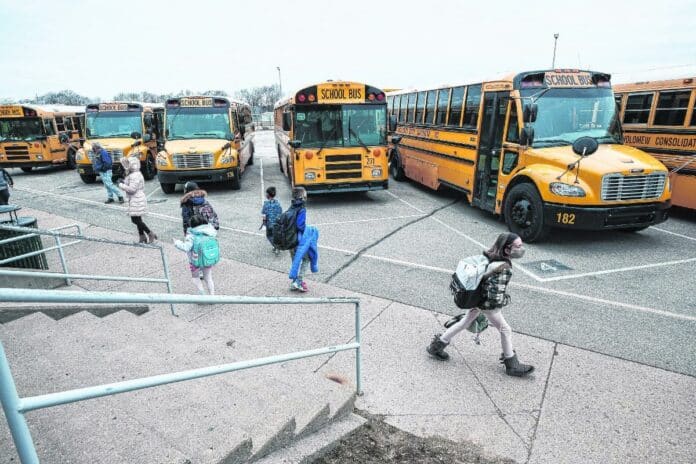
COLUMBUS, Ind. — As Bartholomew Consolidated School Corp. plans how to use an estimated allocation of about $5.9 million in emergency relief funding, the school district has set a main priority for these dollars — hiring as many teachers as possible.
The school corporation has set a goal of hiring 34 teachers for the next two years in “high-need areas, said BCSC Director of Title Services Gina Pleak.
Hiring teachers will be a major priority in how BCSC uses its second Elementary and Secondary School Emergency Relief Fund allocation, she said.
While the amount has yet to be finalized, Pleak said she doesn’t expect the final allocation to vary greatly from about $5.9 million.
The Indiana Department of Education (IDOE) announced ESSER II planning allocations in early February. Under ESSER II, schools will submit allowable expenses incurred from March 13, 2020 through Sept. 30, 2023 and then be eligible for reimbursement.
The funds can be used for a variety of purposes related to the pandemic. There have been several meetings and discussions with various stakeholders, including the Columbus Educators Association and BCSC leadership, about possible uses for the funds, Pleak said. Above all else, the main question BCSC kept asking was “What has the greatest impact on the most students?”
“Our answer always came back to teachers serving students,” Pleak said. “We do know the greatest impact on students and their achievement is the quality of a teacher.”
Pleak said that the ESSER II funds will cover salaries and benefits for the new positions. She added that funds will also go to other necessary expenses such as BCSC’s virtual pathway, professional development, technology, operations and planning.
“Some of that is still unclear at this time,” she said.
Hiring priorities
For the 34 newly-added positions, BCSC is looking at primary grades for elementary schools, English and math teachers for secondary schools, special education positions and English Learner positions.
In this instance, primary grades will refer to grades 1 through 3.
“We’re addressing learning loss, and so we’re not going to add it, necessarily, to kindergarten, because those students didn’t go through the learning loss that potentially could have occurred this year, because they weren’t in school yet,” she said.
In determining which elementary schools to add positions to, Title I schools were considered first. After that, school officials looked at which schools had the space to accommodate more teachers, she said.
The anticipated average primary class size at an elementary level, after adding the new hires, will be 21 students, although the exact number will vary.
With that class size, teachers will hopefully be able to “provide more focus on fewer students,” she said. While BCSC wants students to do well in all subjects, English and math are a priority in this initiative.
“This will give some students the opportunity to retake a math class if they need to, or it’ll give the opportunity for those math classes to be smaller class sizes,” she said.
Recruitment efforts
BCSC has adopted a few different strategies to attract new teachers. These include participating in virtual career fairs through universities, posting on social media and advertising in certain college towns and cities.
The school corporation is also planning its first virtual teacher fair on April 7. Attendees can go to choosebcsc.org to sign up for the event and mark which time slots they’re available for between 8 a.m. to 4 p.m.
Communications coordinator Josh Burnett said that attendees should fill out the interest form by March 26 so that BCSC can reach out to them, confirm the right time slot and help them get in touch with the right people so that they can set up a virtual interview for the fair.
During these informal interviews, applicants will be able to talk to administrators and other BCSC leaders about themselves and their interests and learn more about BCSC. Burnett said that they’ll also be able to share their resumés and cover letters.
At the end of the year, BCSC will have a better idea of what “gaps” it needs to fill due to retirements or other staffing changes, Burnett said.
“Hopefully, we’ll be able to either offer jobs to people as we have openings, or to be able to follow up in the near future about coming and being a part of BCSC in the new school year,” he said.
While every situation will be different based on conversations, as well as the individual’s qualifications and availability, most candidates will likely have at least one more interview later on, Burnett said.
A link to the school’s database of available positions can be found at bcscschools.org, and individuals can apply for positions at the same site. Burnett said that someone who attends the teacher fair and is interested in working for BCSC will want to, at some point, go to that site and apply for a specific job.
Even after the fair is over, BCSC will continue to use the choosebcsc.org site, and individuals will be able to use it about setting up a meeting. While the April 7 event is a sort of “kickoff” for teacher recruitment efforts, and the school corporation will participate in other teacher fairs (which will most likely be mainly virtual) through the end of the year.
Choosebcsc.org also includes links to the school corporation website and other community resources, written testimonies from BCSC educators and reasons to consider joining the school district — such as Columbus being a fast-growing community that recently passed a $5.3 million referendum to increase teacher salaries.
BCSC has also made a promotional YouTube video advertising the fair and promoting both BCSC and the community of Columbus, with Superintendent Jim Roberts stating that the referendum puts BCSC “in the top 10 in the state of Indiana for teacher salaries.”
“I think the tagline for that referendum was ‘recruiting and retaining high quality teachers’, and we’re hoping that that will be the case,” Roberts said.
“With the referendum passing, we feel like we’re uniquely positioned to be able to recruit some great talent that can come in and start their teaching careers or find a new school home within BCSC,” Burnett said. “… We’re focused on finding the best talent, as well as diversifying our teachers too, continually. We’re trying to grow to become more reflective of our student population.”
By the numbers
However, a local teachers’ union has expressed some concern about teacher retention.
A recent internal CEA survey showed that more than 25% of teachers in the school corporation are “seriously considering leaving BCSC after this year.”
CEA second vice president Dakota Hudelson said in a previous interview that while the survey was made up of almost 400 CEA members and did not include non-union teachers, the CEA believes it to be a “representative sample.”
“I don’t know if that’s to go to another school corporation,” he said. “I don’t know if that’s to leave teaching entirely. I don’t know. It doesn’t matter. (The) 25% is a horrifying number, and it’s one that really alarmed us.”
When asked about this figure, Roberts replied that 25% of 400 would be 100, and 25% of the school corporation’s nearly 720 teachers would be 180.
“I do not believe that we will have 100, or 180, teachers choose to leave BCSC at the conclusion of this school year,” he said. “Our typical retention rate is around 90% and I anticipate we will have a similar result this time. If so, then we would have about 72 teachers we would need to replace, not 180.”
He said at the March 1 board meeting that as BCSC looks at certified staff, there are three “buckets” of hiring. The first is for hires needed to make up for annual attrition (approximately 70, as stated above) and maintain current teacher numbers.
The second is additions that the school corporation was already planning to put in place, and the third is the 34 new teaching positions being added with the additional funding.
“So those three areas across the boards, we hire that many people, whatever that number ends up being,” Roberts said.
Pleak likewise said that the 34 teaching jobs are “new, added positions” that come in addition to attrition needs and other positions the school corporation is already looking to fill.
“The ESSER II dollars are only for two years of support,” she said. “… So someone may be concerned — ‘Oh my goodness, what is going to happen to those 34 teachers at the end of those two years?’ And our concerns are not that great, because we’re always hiring, especially in our highest needed areas, which are the 34 positions — those type of categories, like English, math, elementary, EL, special ed. We’re always looking for those kinds of teachers.”
She said that attrition, retirement and resignations will hopefully keep numbers manageable.
“Of course, we always have to re-evaluate based on any current budget, based on what the Indiana legislator may pass for our budget if there’s any cuts,” she added. “But we typically do that every year anyway.”
Pleak said that IDOE has indicated that it will find out its final ESSER II allocation and receive a grant application this month, with the application being due in April.
She said that moving forward, she’ll seek approval of her official ESSER II detailed board report at the board’s April 5 meeting and submit the final application to IDOE.
“With any grant funds, we always have the opportunities to amend if we ever deem necessary,” she said. “If there comes a difficulty of hiring 34 teachers, we can look at other strategies as well.”




